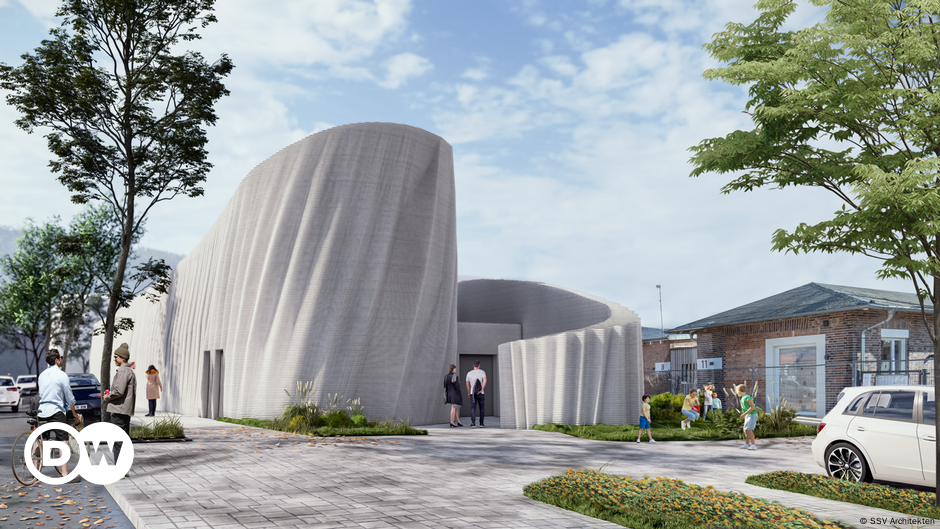The hurdles of creating Europe’s largest 3D-printed building – DW – 06/06/2023
Data centers are not usually known for their extravagant architecture. But the building taking shape in Heidelberg, Germany, is sure to be an eye-catcher. Its curtain like, ruffled facade appears to flow around the structure.
“With this shape, we wanted to push the limits of what is possible,” said Hans-Jörg Kraus, managing partner of Krausgruppe, the developer of the project. The architects’ creative leeway was larger than usual, thanks to a special construction technique: 3D printing.

3D printing means that a computer-controlled nozzle deposits layer upon layer of a special concrete blend — thereby creating the walls of the building. Horizontal elements though, such as the ceilings, still need to be built by traditional methods.
When completed, the one-story data center will be 54 meters long, 11 meters wide and 9 meters high. According to Krausgruppe, this will make it Europe’s largest 3D-printed building upon its completion in July.
3D printing promises to save labor, time and waste
Some of the advantages of 3D printing — beside the extravagant, curved shapes it allows — can be observed at the Heidelberg construction site.
Most of the time, only two workers are on the site to operate the printer. Unlike conventional cast concrete, printed concrete layers maintain their shape, making the use of molds unnecessary.
Eliminating molds reduces waste as well as assembly and disassembly time — it is a “gigantic advantage” of 3D printing, Jan van der Velden-Volkmann, one of the building’s architects, told DW.
It only takes 140 hours to print the building’s vertical elements, according to PERI 3D Construction, a company involved in the project. However, the printing needs to be interrupted for other detailed tasks, so the final layer can only be printed after about four months of work.
As obstacles persist, 3D technology is catching on
Although the technology has been under development for about two decades, 3D-printed buildings are still a rare sight. According to COBOD, a manufacturer of 3D printing technology, 130 buildings larger than 10 square meters (107 square feet) have been printed worldwide up to 2022, with 55 of them completed just last year.
One reason for the slow growth of the technology is the lack of standards to assess the stability of printed structures, according to Arnaud Perrot, a professor of civil engineering at the University of Southern Brittany in France. Without these standards, it is incredibly cumbersome to demonstrate to authorities that printed buildings are safe, he told DW.
But even with standards in place, 3D printing will still face challenges, especially when it comes to building tall structures.

Tall concrete structures are usually reinforced with steel to withstand the forces they are exposed to. This is difficult to do with 3D-printed structures, according to Manu Santhanam, a professor at the department of civil engineering at the Indian Institute of Technology Madras in Chennai.
Hence, for buildings with more than two, or at most three stories, “3D printing is not an option,” Santhanam told DW.
Perrot is more optimistic, at least in the long run. “From a technical perspective, there is nothing that prohibits the printing of multistory buildings,” he said. In the short term, he considers the combination of 3D printing with conventional techniques the easiest way to build higher.
This is also being done in Heidelberg, where the hollow walls created by the printer are filled with conventional, steel-reinforced concrete to improve the stability of the building.

So where can 3D printing play to its strengths? As far as India is concerned, Santhanam sees its greatest potential outside urban areas, where there is less of a need to build tall, especially in large-scale community developments in rural areas.
“If you print a row of houses, let’s say 20 or 30 houses, it will definitely surpass any other technology, because you have the option of individually customizing each house,” Santhanam said.
Another potential growth area for 3D printing is the prefabrication of components in factories, according to Perrot and van der Velden-Volkmann.
Concrete’s big carbon footprint
However, the technology’s reliance on concrete still makes its environmental impact an issue. Concrete contains cement as a binder, the production of which accounted for about 7% of the world’s fossil carbon emissions in 2022, says Robbie Andrew from the University of Oslo.
Researchers have tried printing with less carbon-intensive alternatives, such as clay. But according to Santhanam, the distinct qualities of concrete, such as its strength and durability, mean that it “will certainly dominate” 3D printing in construction.
For the data center, a special concrete blend for 3D printing is supplied by Heidelberg Materials. According to the company, its blend contains a binder with 55% lower CO2 emissions than conventional cement.
Edited by: Tim Rooks
For all the latest business News Click Here

